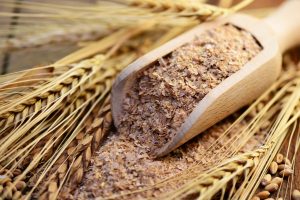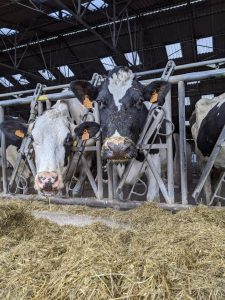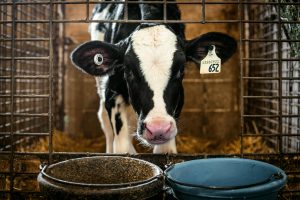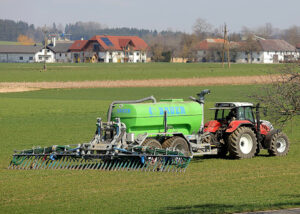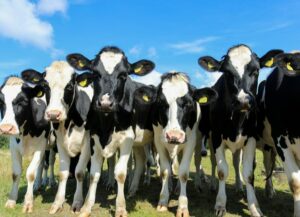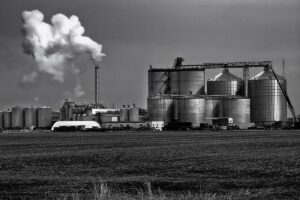Álvaro García
Butyrivibrio fibrisolvens was first described in 1956 by H.A. Bryant and I.M. Small at Washington State University, its role in methane reduction became clearer in the 1970s and 1980s. Studies showed how Butyrivibrio scavenges hydrogen for biohydrogenation, leaving less for methanogens to produce methane. Researchers like M.J. Allison from the University of Illinois were key to understanding its impact on methane metabolism.
Methane production in the rumen depends on hydrogen released during fermentation. This bacterium reduces methane by hydrogenating unsaturated fatty acids, like linoleic acid, into vaccenic acid, a precursor to conjugated linoleic acid (CLA), which offers health benefits to humans. By consuming hydrogen, it limits the amount available to methanogenic bacteria, preventing methane production. This dual role makes Butyrivibrio both an environmental asset and a contributor to CLA production in both milk and beef. While other microbes, (e.g. Ruminococcus bovis) reduce methane indirectly by altering fermentation pathways, Butyrivibrio fibrisolvens directly scavenges hydrogen for biohydrogenation, making it particularly effective in methane reduction.
Feeding for Butyrivibrio fibrisolvens
Increasing the population of Butyrivibrio fibrisolvens in the rumen requires optimizing dietary and environmental conditions. Feeding a high-fiber diet (e.g. hay and silage) can support its proliferation, but the focus should be on easily fermentable, digestible fiber, such as forage plants in early growth stages. High-quality silage or haylage, rich in hemicellulose and digestible cellulose, provides the ideal substrate for Butyrivibrio to thrive while maintaining the energy density needed for production. Avoiding overly mature, indigestible fiber ensures better fermentation and feed passage, supporting both rumen health and animal productivity.
Enhancing the efficiency of Butyrivibrio fibrisolvens to digest fiber can be achieved by combining its activity with exogenous plant enzymes like cellulases. These enzymes break down tough plant cell walls, making cellulose more accessible for bacterial fermentation. By adding cellulases to the diet, fiber is softened, and more surface area is exposed for Butyrivibrio to access. Xylanase, which breaks down xylan in hemicellulose, further enhances this process. The combination of xylanase and cellulase works synergistically to maximize the breakdown of plant cell walls, making hemicellulose more available for fermentation and increasing the production of volatile fatty acids (VFAs) like butyrate and acetate, essential for ruminant energy. To further maximize hemicellulose availability for fermentation by Butyrivibrio, a combination of xylanase and cellulase would likely be the most effective. Xylanase directly targets xylan, a key component of hemicellulose, breaking it down into simpler sugars like xylose, which loosens the plant cell wall and makes hemicellulose more accessible for fermentation. Cellulase complements this by breaking down cellulose, another structural element of plant cell walls. While cellulase does not directly target hemicellulose, breaking down the surrounding cellulose structure helps expose more hemicellulose for fermentation by xylanase. In summary, the combination of xylanase and cellulase is highly effective at breaking down plant cell walls, exposing and making more hemicellulose available for fermentation by Butyrivibrio fibrisolvens.
Enhancing the rumen Butyrivibrio population
One of the key challenges in increasing fiber intake is ensuring that the diet remains energy-dense enough to meet production demands. In high-producing animals, like dairy cows, simply increasing fiber might lower the overall energy available for milk production, leading to subpar performance. To avoid this one should feed digestible forages like immature digestible grasses, high-quality alfalfa, or corn silage. These forages are high in hemicellulose and cellulose, which Butyrivibrio can break down efficiently.
- Inoculating preserved forages with enzymes like cellulase and xylanase boosts fiber digestibility, helping the rumen extract more energy without reducing energy density. To be effective, use at least 170,000 units of cellulase and 630,000 units of xylanase.
- While increasing fiber promotes Butyrivibrio fibrisolvens growth, too much can slow fermentation and reduce feed intake, harming production. Balance fiber with fermentable carbohydrates, like grain starch or added fat, to maintain energy levels and support rumen health. Aim for a more neutral rumen pH (6.0–7.0) by using a well-balanced diet with sufficient fiber and buffers to create an optimal environment for the bacterium’s proliferation.
- Feeding direct-fed microbials with Butyrivibrio or other fiber-degrading bacteria introduces these beneficial microbes into the rumen. Producers should assess dose-response and ROI. Prebiotics like oligosaccharides can also promote Butyrivibrio growth and activity.
Measuring Rumen Fermentation Progress
In modern dairy systems, feed efficiency (measured as milk produced per unit of dry matter intake) typically ranges from 1.6 to 1.8, depending on factors like genetics, feed quality, and management practices. For example, let’s calculate the methane produced by a cow consuming 57 pounds (25.9 kg) of dry matter and producing 90 pounds (40.8 kg) of milk per day.

Methane emissions are measured using methane intensity and methane yield. Methane intensity refers to grams of methane per liter of milk, typically ranging from 20 to 30 grams per liter in modern systems. Methane yield measures the methane produced per kilogram of dry matter intake, generally around 17 to 25 grams per kg. Total methane yield can also be expressed as the daily emission per cow, usually between 400 to 600 grams for high-producing dairy cows.
The methane production per liter of milk produced can be estimated using the formula below, which predicts methane in grams per liter based on the pounds of milk produced and pounds of dry matter intake:

For this example of a cow consuming 57 pounds of dry matter and producing 90 pounds of milk, the methane produced per liter can be estimated as follows:

A methane emission target of 15 grams per liter of milk is considered an ambitious yet attainable goal, particularly when compared to the more typical range of 20 to 25 grams per liter. Achieving this reduction requires optimizing feed quality, incorporating methane-reducing additives, and improving overall cow management practices. Remember that reducing methane not only benefits the environment by lowering greenhouse gas emissions but also improves feed efficiency.
The Cost of Methane Emissions
Let us use a hypothetical feed cost of $6.6 per day per cow. This cow consumes 57 pounds (25.85 kg) of TMR dry matter daily, which contains around 8.79 kg of carbon (based on a typical TMR composition). Given the feed cost above, the price per kilogram of carbon in the TMR is 6.6/8.79 or approximately $0.75. From our previous calculations, we estimated the cow emits 17.3 g of methane per liter of milk, or 692 g of methane total. We know that 75 percent of methane’s weight is carbon, so 0.692 x 75 results in approximately 0.52 kg of carbon lost through methane emissions. With the cost of each kilogram of carbon at $0.75, the cost of the carbon lost in methane equates to approximately $0.39 per day (0.52 x 0.75). This calculation emphasizes how methane carbon represents a sensible cost, highlighting the importance of its reduction strategies. It also gives you a figure to work with to evaluate any methane mitigation products you may consider purchasing.
In summary, reducing methane emissions and improving feed efficiency requires a balanced approach that ensures optimal fermenting conditions and ample fermentable substrates. This can be achieved by offering digestible fiber from high-quality forages and enhancing nutrient availability through additives like cellulase and xylanase in silages. This strategy improves fermentation, reduces methane, and boosts productivity. Methane emissions represent a significant loss of carbon, which was paid for in feed, so reducing emissions is not just environmentally beneficial but also a direct path to improved feed efficiency and farm profitability.
© 2025 Dellait Knowledge Center. All Rights Reserved.



